Vous souhaitez un espace sûr pour expérimenter votre site WordPress sans craindre de casser quelque chose sur votre site en ligne ?
Déplacer votre site WordPress vers un serveur local sur votre ordinateur est la solution parfaite, selon nous, en particulier pour les développeurs, les concepteurs ou les débutants sur WordPress.
Installer WordPress sur votre ordinateur (serveur local) vous permet d' apprendre WordPress facilement et de tester des choses. Lorsque vous déplacez un site WordPress en ligne vers un serveur local, cela vous permet d'expérimenter avec les mêmes données que votre site en ligne.
Dans cet article, nous allons vous montrer comment déplacer facilement un site WordPress en ligne vers un serveur local.
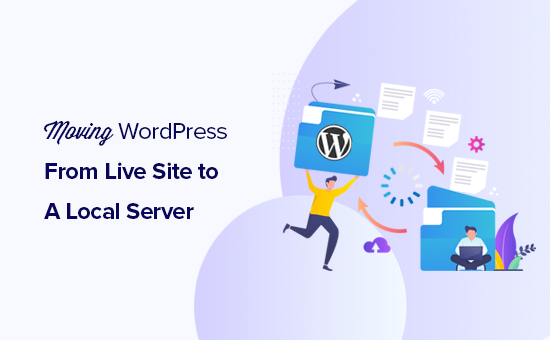
Pourquoi et qui voudrait déplacer un site WordPress en ligne vers un serveur local ?
Si vous utilisez un site web WordPress depuis un certain temps, vous pourriez vouloir essayer de nouveaux thèmes ou un plugin. Cependant, faire cela sur un site web en ligne peut entraîner une mauvaise expérience utilisateur pour vos visiteurs.
Pour éviter cela, de nombreux utilisateurs créent une copie de leur site web WordPress sur un serveur local pour tester de nouveaux thèmes, plugins, ou effectuer des tests de développement.
Cela vous permet de configurer votre thème avec tout votre contenu et de tester toutes les fonctionnalités sans vous soucier de casser votre site. De nombreux utilisateurs copient leur site sur un serveur local pour pratiquer leurs compétences WordPress et de codage avec des données de site réelles.
Même si vous pouvez effectuer tous les tests avec du contenu factice dans WordPress, les données réelles du site vous donnent une meilleure représentation visuelle de la façon dont ces modifications apparaîtront sur votre site en direct.
Préparation du déplacement d'un site local vers un serveur local
Tout d'abord, vous devez vous assurer de toujours sauvegarder votre site WordPress. Il existe plusieurs excellents plugins de sauvegarde WordPress que vous pouvez utiliser.
Deuxièmement, vous devez installer un environnement de serveur local sur votre ordinateur. Vous pouvez utiliser WAMP pour Windows, et MAMP pour Mac. Une fois l'environnement configuré, vous devez créer une nouvelle base de données en utilisant phpMyAdmin.
Visitez simplement l'URL suivante dans votre navigateur pour lancer phpMyAdmin.
http://localhost/phpmyadmin/
http://localhost:8080/phpmyadmin/
À partir de là, vous devez cliquer sur l'onglet « Bases de données » et créer une nouvelle base de données. Vous aurez besoin de cette base de données plus tard pour décompresser les données de votre site en direct.

Vous êtes maintenant prêt à déplacer votre site WordPress en direct vers un serveur local.
Méthode 1. Déplacement d'un site WordPress en direct vers un serveur local à l'aide d'un plugin
Cette méthode est plus simple et recommandée pour tous les utilisateurs.
La première chose à faire est d'installer et d'activer le plugin Duplicator. Pour plus de détails, consultez notre guide étape par étape sur comment installer un plugin WordPress.
Duplicator vous permet de créer facilement un package dupliqué de l'intégralité de votre site web. Il peut être utilisé pour déplacer votre site WordPress vers un nouvel emplacement, et peut également être utilisé comme un plugin de sauvegarde.
Remarque : Il existe une version gratuite de Duplicator avec laquelle vous pouvez commencer. Cependant, Duplicator Pro offre des sauvegardes illimitées et des fonctionnalités plus avancées.
Après l'activation, allez dans Duplicator Pro » Backups depuis la barre latérale d'administration de WordPress. Pour créer un nouveau package, vous devez cliquer sur le bouton « Ajouter nouveau ».
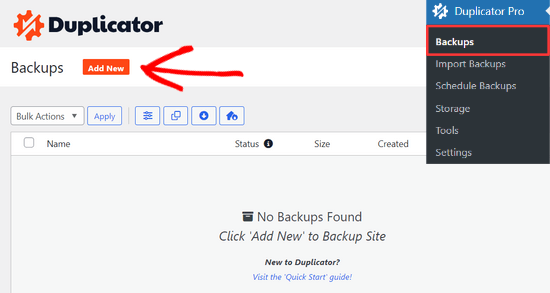
Duplicator lancera alors l'assistant de sauvegarde.
Tout d'abord, vous devez entrer un nom pour votre package de sauvegarde. Vous pouvez également utiliser les balises dynamiques pour créer automatiquement un format de nom tel que la date et le titre de votre site.

Ensuite, développez la section « Stockage » et choisissez un emplacement de stockage.
Pour ce tutoriel, nous utiliserons l'emplacement par défaut. Vous pouvez cliquer sur le lien « Ajouter un stockage » pour ajouter un nouvel emplacement, comme Dropbox ou Google Drive, si vous le souhaitez.
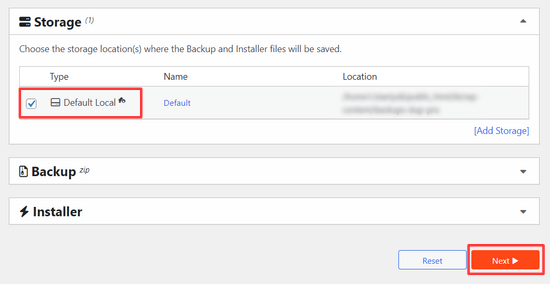
Cliquez sur le bouton « Suivant » pour continuer.
Le plugin va ensuite analyser votre site web et effectuer quelques vérifications en arrière-plan. Il vous montrera ensuite un résumé de ces vérifications.
Si tout semble correct, cliquez sur le bouton « Créer une sauvegarde » pour continuer.
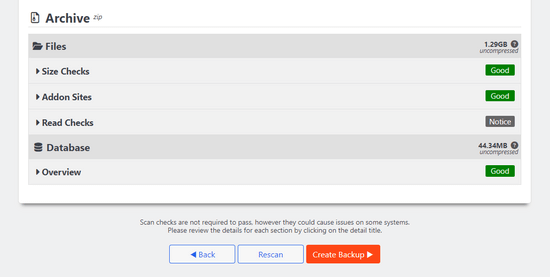
Duplicator va maintenant créer le package de votre site web.
Une fois terminé, vous verrez un fichier zip d'archive contenant toutes les données de votre site web, ainsi qu'un fichier d'installation. Vous devez télécharger les deux fichiers sur votre ordinateur.
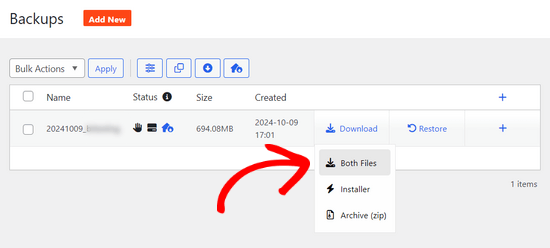
Vous êtes maintenant prêt à décompresser et installer ces fichiers sur votre serveur local.
Tout d'abord, vous devez créer un nouveau dossier dans le dossier racine de votre serveur local. C'est le dossier où votre serveur local stocke tous les sites web.
Par exemple, si vous utilisez MAMP, ce sera le dossier /Applications/MAMP/htdocs/. Alternativement, si vous utilisez WAMP, ce serait le dossier C:\wamp\www\.
À l'intérieur de ce dossier, vous pouvez créer de nouveaux dossiers pour chaque nouveau site web que vous souhaitez importer ou créer sur votre serveur local.
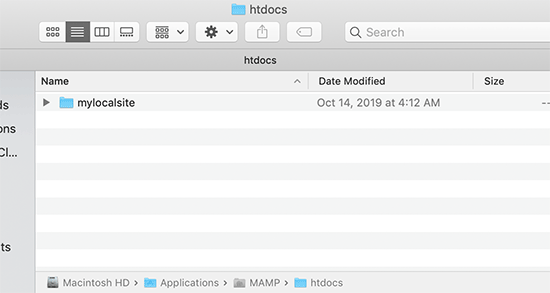
Après cela, vous devez ouvrir le dossier que vous avez créé pour votre site web local, puis copier et coller le fichier zip d'archive et le script d'installation que vous avez téléchargés précédemment.
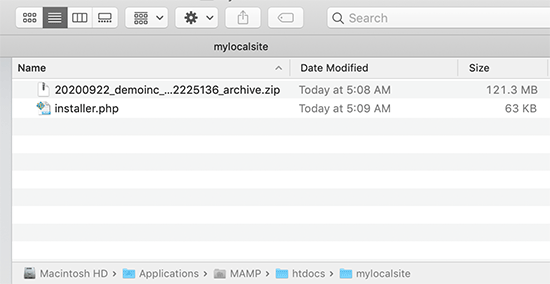
Pour exécuter l'installation, vous devez ouvrir le script installer.php dans votre navigateur web.
Par exemple, si vous avez collé les deux fichiers dans le dossier /mylocalsite/, vous y accéderez dans votre navigateur en visitant http://localhost/mylocalsite/installer.php.
Vous verrez maintenant le script d'installation de Duplicator comme ceci :
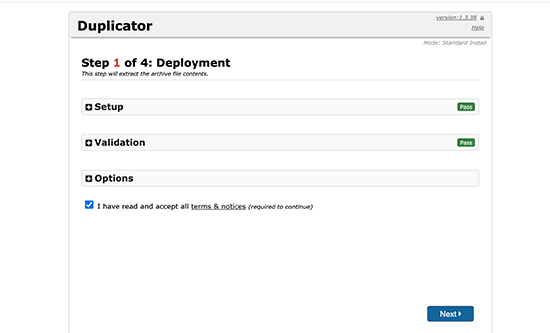
Cliquez sur le bouton « Suivant » pour continuer.
Duplicator va maintenant décompresser le fichier archive zip et vous demandera d'entrer les informations de la base de données de votre site local. C'est la base de données que vous avez créée précédemment.
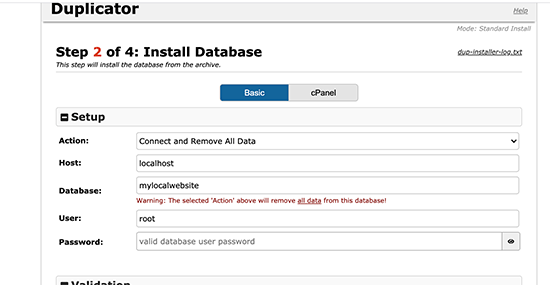
Le nom du serveur est presque toujours localhost et le nom d'utilisateur est root. Dans la plupart des cas, votre installation de serveur local n'a pas de mot de passe défini pour root, vous pouvez donc laisser ce champ vide.
En bas de la page, vous verrez un bouton « Tester la base de données » que vous pouvez utiliser pour vous assurer que les informations de votre base de données sont correctes.
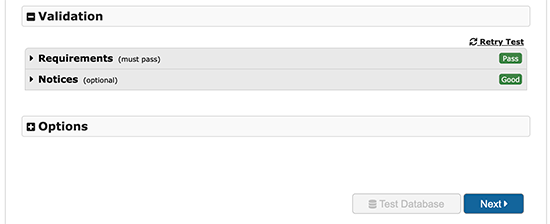
Si tout semble correct, cliquez sur le bouton « Suivant » pour continuer.
Duplicator va maintenant importer la base de données de votre site WordPress. Après cela, il vous demandera de vérifier les informations du nouveau site web qu'il a automatiquement détectées.
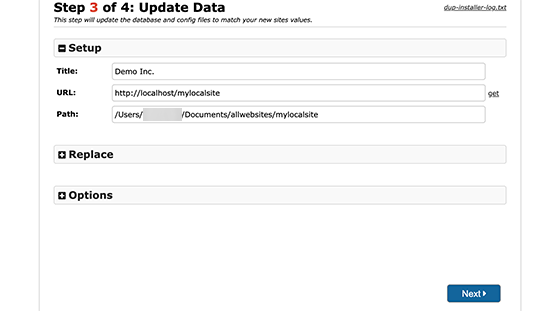
Cliquez sur le bouton « Suivant » pour continuer.
Duplicator va maintenant terminer la configuration et vous montrera un bouton pour vous connecter à votre site local. Vous utiliserez le même nom d'utilisateur WordPress et mot de passe que vous utilisez sur votre site en ligne.
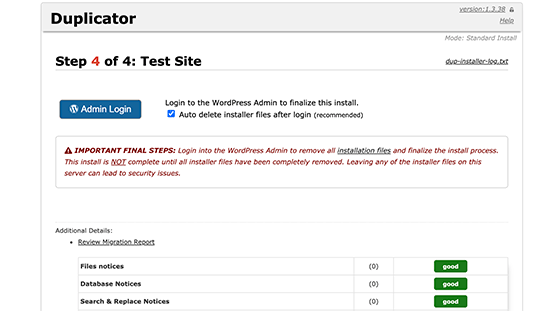
C'est tout, vous avez déplacé avec succès votre site en ligne vers un serveur local.
Méthode 2. Déplacer manuellement un site WordPress en ligne vers un serveur local
Si le plugin ne fonctionne pas pour vous, vous pouvez toujours déplacer manuellement votre site en ligne vers un serveur local. La première chose dont vous auriez besoin est de sauvegarder votre site web manuellement depuis votre compte d'hébergement WordPress.
Étape 1. Exportez la base de données WordPress de votre site en ligne
Pour exporter la base de données WordPress de votre site en ligne, vous devez vous connecter à votre tableau de bord cPanel et cliquer sur phpMyAdmin.
Remarque : Nous montrons des captures d'écran du tableau de bord de Bluehost.
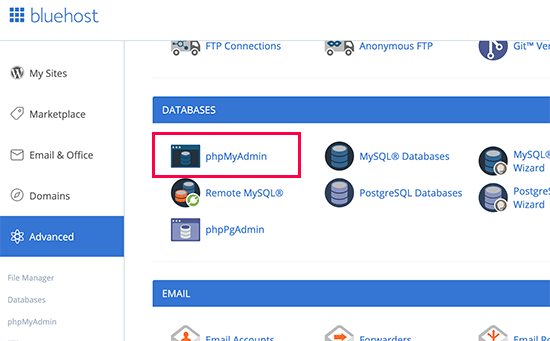
Dans phpMyAdmin, vous devez sélectionner la base de données que vous souhaitez exporter, puis cliquer sur l'onglet d'exportation en haut.
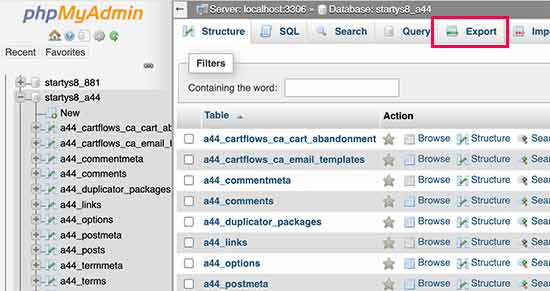
phpMyAdmin vous demandera alors de choisir entre la méthode d'exportation rapide ou personnalisée. Nous recommandons d'utiliser la méthode personnalisée et de choisir zip comme méthode de compression.
Parfois, les plugins WordPress peuvent créer leurs propres tables dans votre base de données WordPress. Si vous n'utilisez plus ce plugin, la méthode personnalisée vous permet d'exclure ces tables.
Laissez les autres options telles quelles et cliquez sur le bouton « Go » pour télécharger votre sauvegarde de base de données au format zip.
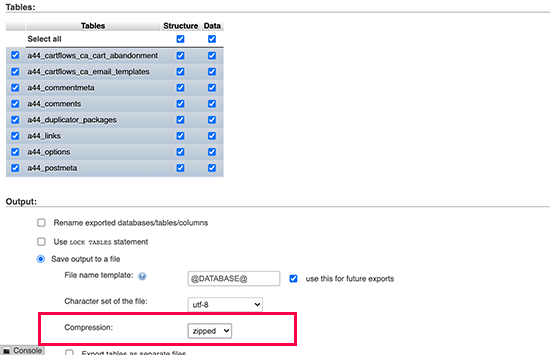
phpMyAdmin va maintenant télécharger votre fichier de base de données. Pour plus de détails, consultez notre tutoriel sur comment sauvegarder manuellement votre base de données WordPress.
Étape 2. Téléchargez tous vos fichiers WordPress
L'étape suivante consiste à télécharger vos fichiers WordPress. Pour ce faire, vous devez vous connecter à votre site WordPress à l'aide d'un client FTP.
Une fois connecté, sélectionnez tous vos fichiers WordPress et téléchargez-les sur votre ordinateur.
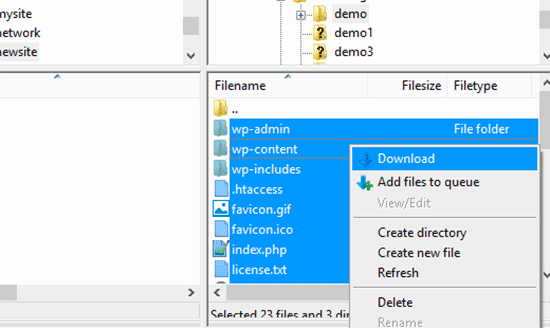
Étape 3. Importez vos fichiers et votre base de données WordPress sur le serveur local
Après avoir téléchargé vos fichiers WordPress, vous devez créer un dossier sur votre serveur local où vous souhaitez importer le site local.
Si vous utilisez WAMP, vous voudrez créer un dossier dans le dossier C:\wamp\www\ pour votre site local. Les utilisateurs de MAMP devront créer un dossier dans le dossier /Applications/MAMP/htdocs/.
Après cela, copiez et collez simplement vos fichiers WordPress dans le nouveau dossier.
Ensuite, vous devez importer votre base de données WordPress. Ouvrez simplement phpMyAdmin sur votre serveur local en visitant l'URL suivante :
http://localhost/phpmyadmin/
Puisque vous avez déjà créé la base de données précédemment, vous devez maintenant la sélectionner, puis cliquer sur l'onglet « Import » en haut.
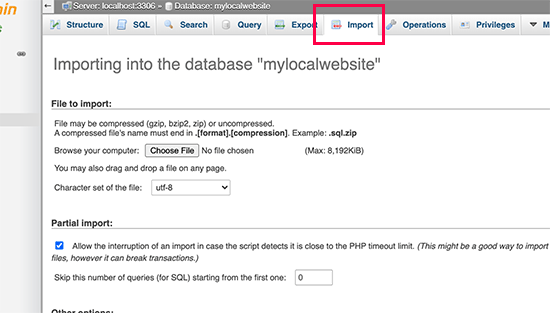
Cliquez sur le bouton « Choisir un fichier » pour sélectionner et téléverser le fichier d'exportation de la base de données que vous avez téléchargé à la première étape. Après cela, cliquez sur le bouton « Go » en bas de la page.
phpMyAdmin va maintenant décompresser et importer votre base de données WordPress.
Maintenant que votre base de données est configurée, vous devez mettre à jour les URL dans votre base de données WordPress faisant référence à votre site en ligne.
Vous pouvez le faire en exécutant une requête SQL dans phpMyAdmin. Assurez-vous d'avoir sélectionné la base de données de votre site local, puis cliquez sur SQL.
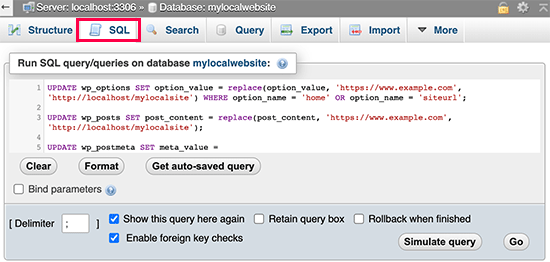
Dans l'écran SQL de phpMyAdmin, copiez et collez ce code, assurez-vous de remplacer example.com par l'URL de votre site en ligne et http://localhost/mylocalsite par l'URL du serveur local de votre site.
UPDATE wp_options SET option_value = replace(option_value, 'https://www.example.com', 'http://localhost/mylocalsite') WHERE option_name = 'home' OR option_name = 'siteurl'; UPDATE wp_posts SET post_content = replace(post_content, 'https://www.example.com', 'http://localhost/mylocalsite'); UPDATE wp_postmeta SET meta_value = replace(meta_value,'https://www.example.com','http://localhost/mylocalsite');
Cette requête remplacera les références à l'URL de votre site en ligne dans la base de données et la remplacera par l'URL localhost.
Étape 4. Mettre à jour le fichier wp-config.php
La dernière étape consiste à mettre à jour le fichier wp-config.php de votre site local. Ce fichier contient les paramètres de WordPress, y compris la manière de se connecter à votre base de données WordPress.
Accédez simplement au dossier où vous avez installé WordPress sur votre serveur local, puis ouvrez le fichier wp-config.php dans un éditeur de texte comme le Bloc-notes.
Remplacez le nom de la base de données par celui que vous avez créé dans phpMyAdmin sur votre localhost.
Ensuite, remplacez le nom d'utilisateur de la base de données par votre nom d'utilisateur MySQL local, généralement c'est root. Si vous avez défini un mot de passe pour l'utilisateur MySQL root sur votre localhost, entrez ce mot de passe. Sinon, laissez-le vide et enregistrez vos modifications.
/** The name of the database for WordPress */
define('DB_NAME', 'database_name_here');
/** MySQL database username */
define('DB_USER', 'username_here');
/** MySQL database password */
define('DB_PASSWORD', 'password_here');
Vous pouvez maintenant visiter votre site local dans une fenêtre de navigateur en entrant l'URL comme ceci :
http://localhost/mylocalsite/
Remplacez 'mylocalsite' par le nom du dossier où vous avez copié vos fichiers WordPress.
C'est tout, votre site WordPress en ligne est maintenant copié sur votre serveur local.
Nous espérons que cet article vous a aidé à apprendre comment déplacer facilement un site WordPress en direct vers un serveur local. Vous pourriez également vouloir consulter notre guide sur la façon de créer facilement un site de staging pour WordPress pour les tests, ou comment déplacer un site WordPress d'un serveur local vers un site en direct.
Si cet article vous a plu, abonnez-vous à notre chaîne YouTube pour des tutoriels vidéo WordPress. Vous pouvez également nous retrouver sur Twitter et Facebook.





Aamir Khan
J'ai créé une sauvegarde de mon site web manuellement et configuré sur une machine locale et exécuté les requêtes ci-dessus, mais mon site web redirige vers la version en ligne.
Support WPBeginner
It seems like you may have not updated the URL, you can do so using step 3 of the manual method of this article.
Admin
George
Merci beaucoup pour cet article clair et utile. J'ai pu le suivre et migrer mon site WP en moins de 20 minutes – et je ne suis pas une experte. Vous m'avez épargné beaucoup de peine – merci.
Support WPBeginner
Glad our guide was helpful
Admin
Barry
Ça ne marche pas pour moi. Je crée le package, mais il installe les fichiers WordPress de base. Donc, quand je navigue vers le dossier, il me demande de configurer WordPress.
Support WPBeginner
Pour la raison la plus courante, vous voudrez vous assurer que vous êtes correctement connecté à la base de données. Si ce n'est pas le cas, l'option de création d'un nouveau site s'affichera au lieu du site correct.
Admin
Daniel
Non, ça ne marche pas pour moi. Tutoriel parfaitement écrit et facile à suivre (à part qu'il dit hhttpps dans la 3ème requête).
J'obtiens ceci dans mon navigateur :
Ce site est inaccessible
localhost a refusé la connexion.
Essayez de :
Vérifier la connexion
Vérifier le proxy et le pare-feu
ERR_CONNECTION_REFUSED
Support WPBeginner
Merci d'avoir signalé cette faute de frappe, elle devrait être corrigée. Pour cette erreur, vous voudrez vous assurer que vous avez correctement mis à jour votre URL à l'étape 3, car c'est la raison la plus courante de ce problème.
Admin
McKenzie
Merci pour votre tutoriel.
La page d'accueil fonctionne partiellement, mais toutes les autres pages ne fonctionnent pas du tout. De plus, il semble que la page d'accueil charge toutes les pages. Qu'est-ce qui pourrait être faux ?
Support WPBeginner
Nous vous recommandons de commencer par consulter notre guide de dépannage ci-dessous :
https://www.wpbeginner.com/beginners-guide/beginners-guide-to-troubleshooting-wordpress-errors-step-by-step/
Admin
Collins
Bonjour, Merci pour cet article super utile.
Je ne sais pas pourquoi le mien ne fonctionne pas, j'ai fait exactement la même chose et obtenu tous les retours corrects. Chaque fois que j'essaie d'ouvrir la page d'accueil localhost/site/, j'obtiens une page qui n'existe pas avec les en-têtes et les pieds de page, et les autres pages pointent toujours vers le site en direct.
Support WPBeginner
Il semble que vous n'ayez pas configuré les URL correctement. Vous voudrez probablement passer à la méthode 2 et essayer les modifications SQL pour mettre à jour vos URL.
Admin
Murat
Pour ceux qui reçoivent l'erreur « wp_options n'existe pas », vous avez peut-être déjà modifié votre préfixe de table. Ouvrez simplement le fichier wp_config.php et vérifiez $table_prefix = ‘wp_’
si la valeur n'est pas "wp_" vous obtenez cette erreur, donc lors du collage du code, modifiez-le en conséquence, par exemple :
UPDATE xx_options SET option_value………..
Support WPBeginner
Thanks for sharing this should someone be running into that error
Admin
Chinwe
Merci beaucoup pour cela. Ça a fonctionné.
Support WPBeginner
Glad our guide was helpful
Admin
Ivana Spasic
Lorsque je copie et colle le code que vous avez fourni dans l'écran SQL de phpMyAdmin, je reçois le message : #1146 – La table ‘xyz.wp_options’ n’existe pas.
Comment cela peut-il être corrigé ?
Support WPBeginner
Vous voudrez vous assurer que vous avez sélectionné la bonne base de données, car c'est la raison la plus courante de ce problème.
Admin
Jill
J'ai utilisé le plugin Duplicator pour configurer une copie d'un site Web pour une organisation à but non lucratif dont j'ai hérité. Après l'avoir rechargé de sorte que tous les plugins soient désactivés, j'en suis finalement arrivé à la conclusion que mon site tente d'utiliser https:// pour se connecter au tableau de bord. Pour me confondre davantage, un site vide que j'ai créé sur localhost n'utilise PAS https:// pour se connecter au tableau de bord. Je comprends la valeur de https:// sur le site en direct, mais il semble qu'il y ait un moyen de le désactiver sur localhost ?
Support WPBeginner
Pour changer l'URL de votre site local, vous pouvez suivre notre guide ci-dessous et supprimer le s :
https://www.wpbeginner.com/wp-tutorials/how-to-change-your-wordpress-site-urls-step-by-step
Admin
Hazel beaver
Existe-t-il un plugin qui permet de télécharger un fichier zip depuis le site en direct, puis de le téléverser dans une nouvelle installation de WordPress sur l'hôte local d'une manière plus simple ?
Support WPBeginner
Pour ce que vous semblez vouloir, le plus proche serait la méthode 2 de ce guide que vous voudrez examiner.
Admin
Daniel
I successfully uploaded to localhost but when i try to use localhost/mysite_location/wp-admin, it redirects to the live site. Not the one on the localhost.
Need help
Support WPBeginner
Vous voudrez accéder à la base de données de votre site, aller dans la table des options, et y modifier l'URL et l'adresse de votre site pour localhost. Pour savoir comment modifier votre base de données, vous voudrez consulter notre article ici : https://www.wpbeginner.com/beginners-guide/beginners-guide-to-wordpress-database-management-with-phpmyadmin/
Admin
Bine
Excellent tutoriel. C'est direct. Malheureusement, je suis toujours redirigé vers le tableau de bord dès que j'essaie d'entrer mon URL. J'ai suivi toutes les étapes, mais il doit manquer quelque chose. Quelqu'un a-t-il une idée de ce que pourrait être le problème ? Merci
Support WPBeginner
Vous voudrez peut-être vérifier la table des options dans votre base de données pour vous assurer que vous n'avez pas défini l'URL du site sur votre zone wp-admin
Admin
Niaz Muhammad
Super tutoriel, merci de partager vos connaissances
Support WPBeginner
Glad you liked our article
Admin
alvaro hernandez
ça marche super bien !!! je t'aime !
Support WPBeginner
Glad our guide was helpful
Admin
T_WA
Salut, merci pour le tutoriel, c'était super utile !!
Cependant, après avoir suivi toutes vos étapes, j'ai des problèmes pour « établir une connexion sécurisée » (je suppose à cause du SSL) et donc ça ne fonctionne pas. J'ai même essayé de changer une ligne 'DB_HOST' en 'localhost/localhost:8888' dans le wp-config.php qui n'était pas mentionnée dans la vidéo mais ça n'a pas aidé.
Aussi, en changeant les liens, j'ai essayé plusieurs variations, rien n'a fonctionné. Quelqu'un a-t-il rencontré un problème similaire et trouvé une solution ?
Support WPBeginner
Avez-vous essayé de vider tout votre cache après avoir mis à jour les URL et y a-t-il l'option de continuer de toute façon sous avancé sur cette page d'erreur ?
Admin
Said
Tout d'abord merci pour ces explications claires que j'ai suivies à la lettre. Le résultat est que j'accède à la page d'accueil de mon site localement, mais les liens de cette page d'accueil ne semblent pas fonctionner car lorsque je clique sur un lien, par exemple :
localhost.mysite.com/subject.html
c'est la page suivante qui s'affiche pour tous les liens :
localhost/dashboard
Pouvez-vous m'aider à résoudre ce problème
Merci d'avance
Support WPBeginner
C'est probablement dû au fait que votre localhost n'accepte pas les permaliens personnalisés : https://www.wpbeginner.com/wp-tutorials/how-to-enable-custom-permalinks-in-wordpress-wamp-installation/
Admin
Ifthikar Hussain
Excellent travail, je rencontre un nouveau problème, c'est que je ne peux accéder qu'à la page d'accueil de mon site WordPress. Comment puis-je accéder aux autres pages ??
Support WPBeginner
Cela dépendrait de l'erreur que vous rencontrez. Pour commencer, vous pourriez consulter les étapes de dépannage dans : https://www.wpbeginner.com/beginners-guide/beginners-guide-to-troubleshooting-wordpress-errors-step-by-step/
Admin
Hannah
Bonjour,
c'est vraiment facile à suivre et utile, merci beaucoup.
J'ai cependant une question très simple.
Lorsque vous mettez à jour les URL, vous dites de remplacer http://example.com par votre site en direct, mais que faire si mon site en direct utilise https ?
Support WPBeginner
Si vous déplacez votre site vers un serveur local, nous recommandons http pour éviter les problèmes d'installation locale dus à l'absence de SSL. Vous passeriez à https si vous déplacez le contenu vers un site en direct qui utilise le SSL.
Admin
Philip
Merci. Vous avez écrit cet article il y a plus de 5 ans, et il est toujours aussi bon. J'ai réussi à tout installer sans trop de difficultés en suivant vos instructions manuelles. Merci particulièrement pour les requêtes SQL.
Philip
Support WPBeginner
Glad our guide could be helpful and still works
Admin
Basem
Après avoir terminé l'installation, je clique sur le bouton Connexion administrateur. le navigateur ouvre une nouvelle fenêtre vers l'installation de wordpress à nouveau ? et la page de connexion n'est pas là
J'ai vérifié les dossiers. tous les fichiers sont copiés.
Patrick
Quelqu'un a-t-il trouvé une solution pour la copie du site localhost (depuis https en direct) où l'administration souhaite utiliser https ?
dowlass
J'ai trouvé que vos instructions pour le déplacement manuel de mon site (du serveur en direct vers localhost) ont bien fonctionné. J'ai dû faire le truc des permaliens – juste cliquer sur « enregistrer » sans rien changer – pour que les liens fonctionnent correctement. Mais sinon, c'est plutôt bien.
Cependant, j'ai rencontré un problème en essayant d'utiliser de nouveaux thèmes. Si j'ajoute un nouveau thème, alors bien sûr le thème s'installe correctement et apparaît sur la page des thèmes. Cependant, si j'essaie de prévisualiser ou d'activer le nouveau thème, j'obtiens une page totalement vierge – même l'administration devient vierge. Le seul recours est d'utiliser le bouton retour du navigateur pour revenir à la vue d'administration où je peux supprimer le thème.
L'ajout de nouveaux thèmes et l'essai de les utiliser font tout planter !
Des idées ?
(p.s. J'utilise une très vieille version de Wordpress – 2.9.2… !! C'est la raison pour laquelle je veux jouer avec sur localhost et trouver la meilleure façon de mettre à jour.)
Michael
Le tutoriel a bien fonctionné mais j'ai eu une « Erreur interne du serveur ». Je téléchargeais une installation réseau complète. J'ai recopié le fichier wp-config.php car il était devenu compressé, tout espacement supprimé. Ensuite, j'ai remplacé le .htaccess par une nouvelle version réseau et le « RewriteBase /sitename/ » était vers le dossier de l'installation, au lieu de « RewriteBase / »
Emma
Les instructions sont claires et directes, mais malheureusement, j'ai un cauchemar total pour faire fonctionner mon site sur le serveur local. Après beaucoup d'essais et j'ai réussi à me connecter à la base de données et à afficher une partie du contenu du site, mais les liens ne fonctionnent pas (ils ne sont apparemment pas trouvés). J'utilise MAMP Pro pour Windows. Peut-être que j'essaierai XAMMP – ou utiliserai un Mac – à la place. Je pense que beaucoup de problèmes sont liés aux permissions, mais je ne sais vraiment pas par où commencer, il semble y avoir tellement de corrections nécessaires !
Support WPBeginner
Salut Emma,
Si vous pouvez accéder à la zone d'administration de WordPress, essayez de visiter Réglages » Permaliens, puis cliquez sur le bouton Enregistrer les modifications sans rien changer.
Admin
andy
J'ai résolu mon problème. Si vous avez déplacé manuellement WordPress sur localhost, et que vous avez installé w3 total cache dans votre WordPress, vous devez vider le cache du navigateur après avoir modifié la base de données et wp-config. Ou ouvrez simplement votre site localhost avec un navigateur différent.
andy
J'ai modifié wp-config et toutes les URL de la base de données en localhost, mais localhost me redirige toujours vers le site en direct. Pourquoi ? Je ne peux plus installer de plugin comme duplicator car le site est déjà supprimé
Suhana
Salut Andy
As-tu essayé de changer les réglages depuis le tableau de bord WordPress ?
Réglages-> Général-> Adresse WordPress (URL), Adresse du site (URL)
Même si cela affiche l'adresse localhost, enregistrez-la et vérifiez. J'espère que cela vous aidera.
Patrick Pogi
Salut wpbeginner,
Merci pour le tutoriel, il m'aide beaucoup. J'ai essayé l'installation manuelle mais à la fin, cela me redirige sans cesse vers la page d'installation de WordPress. S'il vous plaît, aidez-moi, je pense que j'ai presque terminé. J'utilise xampp.
Merci
Jason
Hi,
Im having issues while moving my site, it says LOCALHOST REFUSED TO CONNECT.
But my other local sites are okay.
Im moving it to local because something gone terribly wrong and my page woun’t load on the server’s.
Toute suggestion ou conseil est apprécié
John
Dans les préférences de MAMP, réglez vos ports sur – Apache 80, Nginx 443 et MySQL 3306 et voyez si cela résout le problème
Steve
Merci pour cet article, je l'ai trouvé très utile mais j'aimerais y ajouter quelque chose si je peux.
J'ai utilisé la méthode manuelle avec succès à une exception près : je ne pouvais naviguer vers aucune des pages ou articles depuis le menu de mon site. J'obtenais une erreur « page non trouvée ». J'ai tout essayé ici, en enregistrant les permaliens, mais rien n'a fonctionné. J'ai finalement trouvé un article ailleurs qui m'a donné la solution. J'ai dû modifier une ligne dans le fichier httpd.conf d'Apache. Ouvrez le fichier et recherchez 'AllowOverride'. S'il ressemble à ceci : 'AllowOverride None', changez-le en 'AllowOverride All'. Je ne pouvais pas accéder à toutes les pages et tous les articles et voir tout le contenu ! Pour information, il existe plusieurs options 'AllowOverride' mais celle que vous recherchez se trouve sur une ligne à elle seule. Je sais que ce n'est pas un forum de configuration WordPress mais Apache, mais d'autres pourraient rencontrer le même problème. J'espère que cela aidera.
Braun Philippe
Bonjour à tous,
I’m running into a serious problem. When I click on my local site forler with servers ON on MAMP, it redirects to live site I’ve done everything this tutorial says, do you know where is the problem ?
I’ve done everything this tutorial says, do you know where is the problem ?
Merci pour votre aide
Sara
Salut
J'ai aussi un écran blanc comme IDRIS D... des suggestions ?
Idris D
Unfortuntely when I follow this guide, all the links in my local site redirect to the live site.
Any suggestions?
Adrian Stangell
Hi,
after following the instructions for the manual migration I end up with a blank screen when I try to access my website on the localhost. Any ideas?
Joel M
Après avoir exécuté la requête SQL pour remplacer les liens, je reçois une erreur 1064 – il semble y avoir un problème avec la syntaxe du code. Je suppose que c'est le (:) dans mon URL localhost : ‘http://localhost:888/localwebsite’ – des idées sur la façon dont je peux contourner cela ? J'utilise MAMP pour exécuter le serveur local.
Aaron L
essayez quatre '8' au lieu de 3…. localhost:8888/localwebsite
Natalie Bell
Salut !
J'ai réussi ma migration vers le site local, à l'exception de ma médiathèque. Toutes les images sont là (beaucoup de fichiers), les URL sont correctes, mais elles n'apparaissent pas sur le blog lui-même. Quand je vais dans la médiathèque, elle affiche juste la grille des photos – toutes vides, mais dans la description, l'URL, etc., tout est correct.
Avez-vous une idée de ce qu'il faut faire ensuite ?
Grant
Essayez d'aller dans votre tableau de bord WordPress, cliquez sur le menu Paramètres près du bas de la barre latérale gauche. Ensuite, cliquez sur le menu Lecture dans le sous-menu Paramètres, faites défiler jusqu'aux options de visibilité du site et sélectionnez l'option « Autoriser les moteurs de recherche à indexer » et cliquez sur Enregistrer les modifications en bas de la page. Voyez si cela fonctionne, sinon vous devrez peut-être aller dans votre terminal et extraire manuellement les fichiers multimédias de votre ancien site de manière récursive – j'ai dû passer par là et je peux vous guider si vous avez des questions. J'espère que cela vous aidera.
Carolina
Salut, Merci pour le post, c'est un énorme succès pour moi.
Jusqu'à présent, j'ai réussi à accéder à la page wp-login.
et je suis désolé si c'est une question très stupide. mais je suis vraiment novice avec wp
mon problème est que je ne peux pas me connecter :$
J'ai essayé les mêmes identifiants que les détails du site en ligne = ça ne marche pas
comme je n'ai pas configuré le tableau de bord et que c'est en local. aucun e-mail ne fonctionnera.
Que dois-je faire ?
Au fait, c'est sur un Mac.
Merci d'avance. Toute aide est appréciée !!
Support WPBeginner
Bonjour Carolina,
Vous pouvez changer de mot de passe en utilisant PHPMyAdmin.
Admin
DavidA
Re-salut,
Mes sincères excuses ! J'ai posté un commentaire hier (24 juillet) concernant la difficulté à exécuter le programme Duplicator depuis mon navigateur. Je suis retourné vérifier aujourd'hui et j'ai réalisé que j'avais fait une erreur dans le placement du dossier "test-site" qui contenait l'installer.php et la base de données zip.
Une fois que j'ai vraiment placé ce dossier dans le dossier htdocs, tout a fonctionné correctement et j'ai pu installer les données du site web localement comme indiqué dans vos instructions.
Merci encore pour toute votre aide !
DavidA
Bonjour — merci encore pour un autre excellent article ! Tout est très utile !
Je suis à l'étape d'ouverture de l'installateur Duplicator sur mon ordinateur local. Cependant, lorsque je tape « http://localhost/test-site/installer.php » dans mon navigateur, j'obtiens un « message d'erreur 404 » indiquant « objet introuvable ».
Curieusement, si j'utilise « localhost » seul ou « localhost/phpmyadmin », les deux fonctionnent. J'ai déplacé le dossier « test-site » dans le dossier « htdocs » mais cela ne fonctionne toujours pas.
Des suggestions ??
Merci
Shun
Merci pour ce guide, mais que faire si vous migrez d'un site en direct avec un certificat SSL vers un site de développement sans SSL (https vers http ?)
J'ai fait fonctionner le front-end correctement, cependant, HTTPS est toujours ajouté à mon URL wp-login, m'empêchant d'accéder à la page de connexion à l'administration.
Des étapes supplémentaires sont-elles nécessaires pour éliminer https sur la page de connexion WP d'un site local/de développement ?
simone
J'ai un problème similaire. J'ai migré un site en ligne vers MAMP en utilisant le plugin WP Migrate DB et FTP. J'obtiens l'erreur suivante – due au certificat SSL du site en ligne. Cela a quelque chose à voir avec les préfixes de base de données qui ne correspondent pas. Mais – je ne peux pas changer le préfixe sur le site en ligne. J'ai appelé Go Daddy pour voir si modifier le préfixe du site en ligne pour qu'il corresponde au préfixe de ma base de données locale casserait le site, ils ont dit qu'il n'y avait aucune garantie, j'ai essayé et cela a cassé le site.
message d'erreur que j'obtiens en entrant l'URL localhost:8888.
An error occurred during a connection to localhost:8888. The client has encountered bad data from the server. Error code: SSL_ERROR_BAD_SERVER
The page you are trying to view cannot be shown because the authenticity of the received data could not be verified.
Please contact the website owners to inform them of this problem.
Merci d'avance pour toute aide !
xasmatic
Well, i used SSL certificate and that is what I did:
At the step where you have to update the URLs inside your WordPress database referencing to your live site, you write the SQL query 4 times to change every URL that may exist.
First time write code like above “http://www.example.com”, then “http://example.com”, after that “https://www.example.com” and finally “https://example.com”.
Make sure: 1) that you write all four times the URL
http://localhost/test-sitewhich will replace those URLs2) change wp_options, wp_posts and wp_postmeta to your right ones (mine for example were cagwp_options etc.)
Et un dernier rappel : Enfin (si vous déplacez sur localhost), à la dernière étape, vous devez également changer le nom d'hôte en localhost (fichier wp_config.php)
/** MySQL hostname */
define(‘DB_HOST’, ‘localhost’);
Veer Abheek Singh Manhas
J'ai essayé d'utiliser cet article mais je ne suis pas sûr à quel moment je suis censé installer WordPress. Quelqu'un peut-il m'aider ici ?
Merci
AIAI
vous n'avez pas à réinstaller WordPress. tous les fichiers de l'installation wp source sont déjà sauvegardés.
Alex
J'ai déjà utilisé ces instructions et elles ont bien fonctionné, cependant j'ai maintenant une version mise à jour de MAMP et WordPress et j'obtiens continuellement des erreurs. En jouant, j'obtiens l'écran blanc vide ou le fichier index.php. comme texte.
Deux problèmes similaires à ceux des utilisateurs ci-dessous.
il est peut-être temps de mettre à jour ceci.
J'ai abandonné l'idée de déplacer mon site en local et j'ai décidé d'avoir également une URL de développement. Cependant, lorsque j'exécute la requête SQL ci-dessus, je me retrouve toujours avec une incohérence de jeton, malgré toutes les modifications nécessaires.
Andi
Merci beaucoup pour votre travail.
Mais ça ne marche pas. Si j'exécute local installer.php, j'ai un écran vide.
Cordialement
Andi
mc
salut
J'ai tout fait comme c'est décrit et quand j'arrive à la dernière phase et que je mets l'URL : localhost/mysite, cela télécharge automatiquement un fichier qui contient ces informations :
/** * Tells WordPress to load the WordPress theme and output it. * * @var bool */ define('WP_USE_THEMES', true);
/** Loads the WordPress Environment and Template */ require( dirname( __FILE__ ) . '/wp-blog-header.php' );
est-ce que j'ai fait quelque chose de mal dans le processus ?
Albert Smit
Je n'ai pas réussi avec le plugin Duplicator mais j'ai réussi à faire fonctionner mon site plus ou moins manuellement.
J'ai maintenant un autre problème. Mon site s'ouvre correctement mais je ne peux rien faire. Je reçois constamment des erreurs 404 Page not Found. Cela se produit avec mes éléments de menu, la barre de recherche, le bouton de connexion, etc. Je ne peux aller nulle part sur mon site. Que dois-je faire ?
Albert
Matthew
404 signifie que la page n'est pas trouvée, il semble que vous n'ayez pas mis à jour les URL de votre base de données, assurez-vous de suivre cette étape. toutes vos ancres pointent vers des liens qui ne sont pas disponibles sur votre serveur.
Albert Smit
J'ai fait tout le processus à partir du fichier zip et install.php. À l'étape 3, lorsque je clique sur Enregistrer les permaliens, cela m'amène à l'écran de connexion WP. Peu importe ce que je tape, le résultat est toujours le même : Nom d'utilisateur invalide. J'ai exécuté Duplicator deux fois maintenant, toujours pas de succès. S'il vous plaît, aidez-moi.
Albert
Richard
Je voulais juste dire merci pour une description aussi géniale et directe.
J'avais essayé cela plusieurs fois auparavant en utilisant les informations de wordpress.org mais cela n'avait jamais fonctionné.
J'ai suivi votre article étape par étape (méthode manuelle, sans plugin) et cela a parfaitement fonctionné !!
Merci
Support WPBeginner
Salut Richard,
Glad you found it useful Don’t forget to join us on Twitter for more WordPress tips and tutorials.
Don’t forget to join us on Twitter for more WordPress tips and tutorials.
Admin
LS
Merci beaucoup pour ce tutoriel !
J'ai effectué l'installation manuelle, bien que cela n'ait pas tout à fait fonctionné au début. J'ai eu une erreur de connexion à la base de données. Peut-être que la plupart d'entre vous le savent déjà, mais je ne l'ai vu qu'en y regardant de plus près :
Dans mon fichier wp-config.php, sous DB_NAME, DB_USER et DB_PASSWORD, il y avait cette ligne :
/** nom d'hôte MySQL */
define(‘DB_HOST’, ‘host.example.de’);
J'ai dû remplacer ‘host.example.de’ par ‘localhost’ pour résoudre le problème. Maintenant, ça fonctionne à merveille.
Thank you again and i hope you have a fantastic day!
Cordialement LS
Abraham Quilca
Oui, pareil ici. Cela devrait absolument être mis à jour dans l'article pour faire gagner du temps aux futurs visiteurs.
RF
Ce site m'a sauvé la vie plusieurs fois. Continuez comme ça !
Olivia
Merci !!!